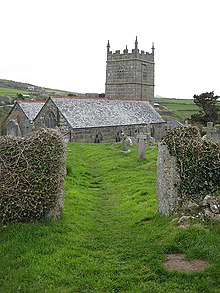St Senara's Church
| Church of Saint Senara | |
|---|---|

St Senara's Church in Zennor
|
|
| 50°11′30″N 5°34′03″W / 50.1918°N 5.5674°WCoordinates: 50°11′30″N 5°34′03″W / 50.1918°N 5.5674°W | |
| Denomination | Church of England |
| History | |
| Dedication | Saint Senara |
| Architecture | |
| Heritage designation | Grade I listed |
| Designated | 10 June 1954 |
| Administration | |
| Parish | Zennor |
| Deanery | Penwith |
| Archdeaconry | Cornwall |
| Diocese | Truro |
| Province | Canterbury |
| Clergy | |
| Vicar(s) | Revd. John Holland |
St Senara's Church, or The Church of Saint Senara, in Zennor Churchtown, Cornwall, England, UK, is the parish church of the parish of Zennor. It is in the Deanery of Penwith, Archdeaconry of Cornwall, and Diocese of Truro. It is dedicated to the local saint, Saint Senara, and is at least 1400 years old, though it was rebuilt in the 12th century. It is a Grade I listed building.
A church dedicated to Saint Senara has stood on the current site overlooking the sea since at least the 6th century AD, but the current building is partly Norman and partly of the 13th and 15th centuries (the north aisle 15th century). There is a west tower and the octagonal font may be from the 13th century. It was reputedly founded by Saint Senara on her return from Ireland with her son, who was by then a bishop, when they founded the village of Zennor.
One of only two remaining bench-ends in the church portrays the Mermaid of Zennor, depicted admiring herself in a mirror. This is on the so-called "Mermaid Chair" which also has carvings of fish on the seat, and which is believed to be at least 600 years old.
The tower contains tombstones, including one with an inscription for a "Hen-pecked husband" with a beautiful engraving for the "four winds which daily toss this bubble". On the church's outside wall, next to the west porch, is a memorial to John Davy, 1891, the last person to speak Cornish fluently. The church is surrounded by a small circular graveyard, the boundaries of which have existed since the Bronze Age and in which parish residents have been buried for centuries.
Both this church and the church of the nearby village of Morvah lay claim to the local legend of a cow eating the bell-rope, at a time when such items were fashioned from straw.
...
Wikipedia

